Robinson Shipshape and Ready to Sail
Pete Herrmann, David Robinson’s last coach back in the salad days at Navy, made sure Robinson didn’t forget this summer just what he was planning to undertake.
“Coach Herrmann came to my house and he talked to me before the season started, tried to give me a little pep talk to get ready,” Robinson said. “He left and I came back to my refrigerator and on the calendar it had the day (Oct. 6) circled. It said, ‘Get ready to go with the big boys.’ ”
As if Robinson didn’t know. That day was the start of the San Antonio Spurs’ training camp. The day he could finally step on a basketball court again, after his two-year service obligation with the Navy ended in May, and show people why the Spurs started giving him $27 million two years ago.
Those Navy days are over. Annapolis now belongs to brother Chuck, a 6-foot-5 freshman (“I can’t say he’s really enjoying the Academy, but he’s surviving,” big brother said). Now the woods are full of seven-footers, dozens of them. David Robinson has to stake out his own territory.
Now Robinson starts in the middle for the Spurs, who are coming off a 21-61 debacle of a year under Coach Larry Brown. Brown cleaned house; only three players are left from last season’s team -- Willie Anderson, Frank Brickowski and Vernon Maxwell.
Through trades Brown brought in all-stars Terry Cummings and Maurice Cheeks, along with David Wingate. Free agency produced veteran Caldwell Jones, a mentor if there ever was one with 17 NBA campaigns under his belt. The draft brought forward Sean Elliott from Arizona with the third pick.
So the rebuilding is not just Robinson’s arrival.
If he had to go it alone, “it definitely would have been a nightmare for the first year or two,” he said. “Nobody really deserves that kind of pressure and I’m glad they did make those moves. These guys are great. Especially with their leadership more than anything else.
“Caldwell knows a little bit about everybody that we’ve played. He knows what to expect, so everything’s not so much a surprise to me. It helps with my attitude in approaching the referees, approaching the pace of the game and everything. That’s just invaluable. You take away some of those blind obstacles and it makes the path a lot smoother.”
If his pre-season performance is an indication, Robinson’s already done away with the rust just about everyone thought would take him much longer to shed. He leads San Antonio in scoring at 22.2 points per game, on 52.3 percent shooting from the floor. He’s second in rebounding at 8.4 a game, with 13 assists and five blocks.
“The man is a phenomenon,” Jones said. “The whole country is throwing praise on him, so there must be something to it. So that’s why I said, ‘Hey, if half of that can be true, he’s going to be a force in this league for a long time.’ ”
Here was a significant test. The Spurs played the Knicks in Madison Square Garden, meaning Robinson hooked up with Patrick Ewing, one of his pro teachers during preparations for the Olympic team. Ewing had 25 points and eight blocks but Robinson more than held his own, with 22 points, nine rebounds, four assists, a block and a steal in 31 minutes.
And the Spurs won the pre-season matchup, 104-99. For this team, any win over a team such as the Knicks, any time, is big.
“I’m just like everybody else,” Robinson said. “I don’t give anybody respect until they earn it. I see these guys, Larry Bird, Pat Ewing, (Akeem) Olajuwon, all these guys on TV and, yeah, they’re good and everything. But until they come out on the court and they come out and play against me, that’s when they start to earn their respect. And I’m sure it’s that way with everyone else when I come out on the floor. They’re not going to give me anything until I perform.”
Of course, now the comparisons will begin, if they haven’t already, between the last Olympic center and the 1984 version.
“People will always compare us,” Ewing said. “It’s like comparing me and Akeem. . . . Tonight, (Robinson) did an outstanding job. He’s very quick, and agile, and he’s very smooth with his footwork. He can play.”
No one doubted Robinson would get out in transition to score points--and he had a rim-rattling slam dunk on the break Tuesday, courtesy of a textbook bounce pass by Cheeks. But he also was able to get angles on Ewing, not a speed merchant but no slow goer, in the halfcourt offense. And when Ewing went up for a dunk in the first quarter, Robinson stuffed him.
He’s still not your prototype NBA center. Ewing didn’t have much trouble getting his shots off over him and except for the first quarter, Robinson didn’t rebound as well as Brown would like. Typical rookie stuff.
“When Patrick came into the league everybody said he’d be an intimidator and a rebounder to start with, and his offense surprised most people,” Brown said. “David’s adjustments (are that) his offense is far ahead of his defense. The physical part of the defense, the banging and the pushing, the post play is tough.
“But he’s just feeling his way. He’s not your typical basketball junkie who played all the time. It’s amazing. He didn’t start playing (organized basketball) until just recently and I think every day is a learning process for him. But he’s bright and he wants to do well.”
Brown taught Robinson another lesson when New York’s Gerald Wilkins and San Antonio’s Anderson started shoving each other. The other Knicks rushed to Wilkins’s aid. Robinson stood under the foul line and Cummings had to step in for San Antonio.
Brown quickly called time and spent a lot of it telling Robinson he better stick his nose in the next time. Sure enough, when Cummings and Charles Oakley squared off in the second half, Robinson was among the first there.
Those kinds of things are the reason Herrmann felt compelled to remind Robinson just how hard it would be. “Any time I see something I take as a motivational technique for David, I give it to him,” Herrmann said. “His old coach always wants him to improve, to be the best basketball player he could be. He’s so multi-dimensional he likes everything.”
Robinson acknowledged that while he was a two-time all-America at Navy, it was hard for him to always come out and be the best guy on the court. He could get away with that against some lesser college teams. Even in the Olympics, he struggled with that, and after the Soviet Union defeated the United States in the semifinals, a lot of people blamed him.
“For a long time, I blamed myself,” he said. “You can’t do that. You’ve got to come out and give what you have, and if you don’t win, you don’t win.”
“He always had that trouble (of excelling) when he came to practice,” Herrmann said. “He could get through practice. But now that practice is preparing him for major competition.
“John Thompson asked me if he had heart all through the Olympic trials. I said, ‘Every time we met the challenge, he was there.’ ”
As the lynchpin for his new team, Robinson has more challenges, more expectations. But in Brown’s passing game, he doesn’t have to stay anchored to the post. He’s at the top of the key nearly as often as he is down low. And that’s fine with him, because it’s basketball again.
Some person with no appreciation of the Navy life asked him Tuesday how it felt to be back after all that time off. You could see the military man bristle at the effrontery. “I don’t really think of it as I had time off,” he said. “Now I’m 24 years old and I have to work with what I have. . . . I don’t look back. I don’t say it could have been better or it could have been worse. Now I just try to work with what I have and I think it’s coming along pretty good.”
More to Read
Get our high school sports newsletter
Prep Rally is devoted to the SoCal high school sports experience, bringing you scores, stories and a behind-the-scenes look at what makes prep sports so popular.
You may occasionally receive promotional content from the Los Angeles Times.






